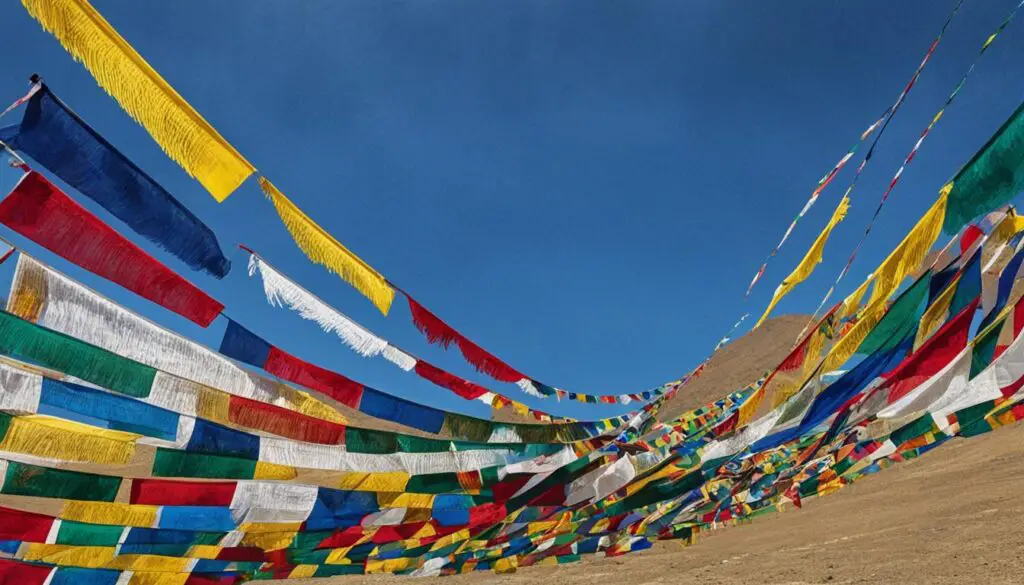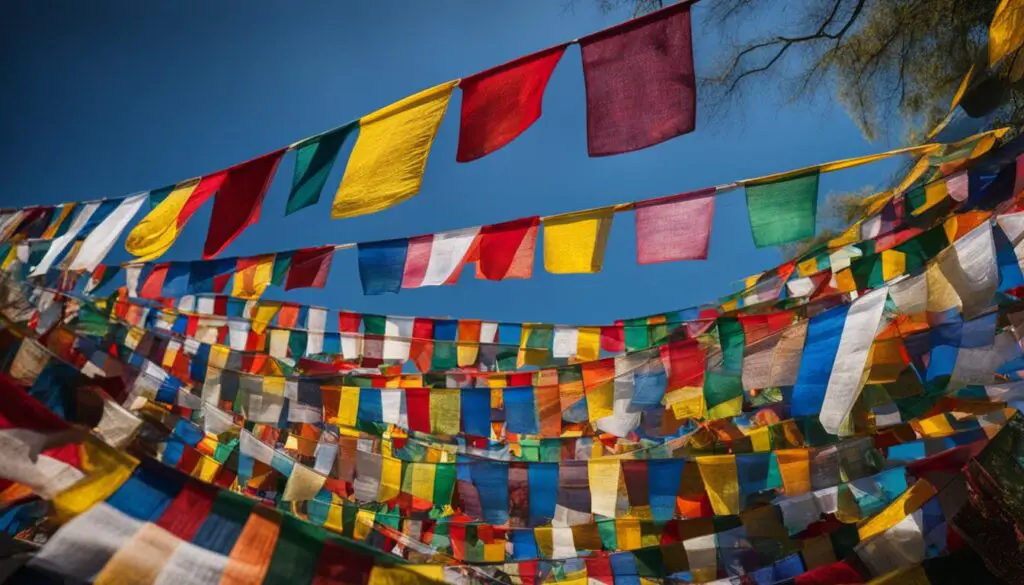Discover the vibrant world of traditional prayer flags and their deep cultural significance in Tibetan Buddhism. These sacred and spiritual flags have been an integral part of religious ceremonies and traditions, spreading positivity and goodwill wherever the wind carries them.
Key Takeaways:
- Traditional prayer flags hold deep cultural significance in Tibetan Buddhism.
- They are an integral part of religious ceremonies and traditions.
- Prayer flags symbolize compassion, peace, strength, and wisdom.
- Each color, design, and text on the flags carries specific meanings.
- When hung in the wind, prayer flags are believed to spread positive energy and goodwill.
The History of Tibetan Prayer Flags
In order to understand the significance of Tibetan prayer flags, it is essential to delve into their rich history. Prayer flags have deep roots in ancient practices that predate Tibetan Buddhism, originating from the Bon religion. The Bon religion, which has its origins in Tibet, employed colored cloths as offerings to the gods and as a means to maintain harmony in nature.
With the emergence of Tibetan Buddhism, the practice of using prayer flags was absorbed and incorporated into its religious traditions. This integration enhanced the symbolism and spiritual significance of the flags. Tibetan prayer flags became revered symbols, believed to carry the power of spreading compassion, peace, strength, and wisdom.
However, the history of Tibetan prayer flags took a tumultuous turn during the Chinese invasion of Tibet in 1949. The Chinese authorities discouraged the practice of flying prayer flags, leading to the loss of many traditional designs and the suppression of this ancient tradition. Despite the challenges faced during this period, Tibetan refugees and devoted Buddhists from Nepal played a crucial role in preserving this sacred tradition.
Image:

The image above visually portrays the resilience and endurance of the prayer flag tradition.
Amidst the cultural upheaval caused by displacement and persecution, these individuals held steadfast to the ancient practice of flying prayer flags, ensuring its survival and passing on the invaluable knowledge of prayer flag designs, meanings, and proper hanging practices from one generation to another. Today, Tibetan prayer flags continue to be a cherished part of Tibetan cultural heritage, a symbol of resilience, and a source of spiritual inspiration.
Meaning and Symbolism of Prayer Flags
Tibetan prayer flags carry layers of meaning and symbolism. Each aspect of these vibrant flags holds significance that contributes to their spiritual and cultural value. Understanding the meaning behind the colors, elements, texts, and symbols is key to appreciating the profound message they convey.
Colors Representing the Elements of Nature
The colors of Tibetan prayer flags symbolize the elements of nature, reflecting the harmonious relationship between humans and the natural world. The five colors commonly used are:
- Blue: Represents the sky, infinite space, and boundaryless compassion.
- White: Symbolizes air, clouds, purity, and spiritual power.
- Red: Signifies fire, energy, dignity, and the transformation of negativity into positivity.
- Green: Represents water, nature, fertility, and harmony.
- Yellow: Symbolizes earth, generosity, openness, and the qualities of Buddha.
Texts and Symbols Conveying Prayers and Blessings
The texts and symbols depicted on Tibetan prayer flags carry profound prayers and blessings, promoting peace, wisdom, compassion, and well-being. These include:
- Mantras: Sacred syllables or phrases that invoke divine energy and protection.
- Sutras: Buddhist scriptures containing teachings and wisdom.
- Prayers: Expressions of aspirations for peace, harmony, and enlightenment.
When these texts and symbols are suspended in the wind, it is believed that the prayers and blessings they carry are carried and spread, benefitting all who come into contact with them.

“Tibetan prayer flags carry deep meaning and symbolism, symbolizing the interconnectedness between humans and nature. Their vibrant colors represent the elements of the natural world, while the texts and symbols convey prayers and blessings for peace, wisdom, and compassion.”
Types and Designs of Tibetan Prayer Flags
Tibetan prayer flags come in different designs, each with its own unique characteristics and purpose. The two most common types of Tibetan prayer flags are Lungta flags and Darchor flags.
Lungta Flags

Lungta flags are square or rectangular in shape and are often strung horizontally or diagonally. These flags are commonly arranged in groups of five and hung between high places such as temples, mountain peaks, or spiritual retreats. They flutter in the wind, carrying prayers and positive energy to all directions.
The arrangement of Lungta flags in groups of five holds significance in Tibetan Buddhism. Each flag represents one of the five elements: sky, air, fire, water, and earth. The combination of these elements symbolizes a harmonious balance in nature.
Lungta flags are adorned with various symbols and prayers that invoke blessings, compassion, and wisdom. The vibrant colors and intricate designs make these flags visually appealing and spiritually uplifting.
Darchor Flags

Darchor flags are large rectangular flags that are hung vertically on poles. They can be found planted in the ground, on mountains, or on rooftops. Darchor flags are often used as boundary markers, indicating sacred spaces or land that holds spiritual significance.
These flags typically feature bold colors and prominent symbols. The designs may include auspicious animals, deities, mantras, and prayers. Darchor flags serve as a visual representation of intentions and aspirations, inviting positive energy and protection from unseen forces.
| Flag Type | Shape | Arrangement | Symbolism |
|---|---|---|---|
| Lungta flags | Square or rectangular | Horizontally or diagonally | Representation of the five elements and prayers for blessings and balance |
| Darchor flags | Large rectangular | Vertically on poles or planted in the ground | Boundary markers, protection, and invocation of positive energy |
Both Lungta and Darchor flags have a profound spiritual significance and are deeply rooted in Tibetan Buddhist traditions. Regardless of their specific design and arrangement, Tibetan prayer flags serve as powerful conduits to promote peace, compassion, and spiritual well-being.
How to Hang Prayer Flags
When it comes to hanging prayer flags, it’s not just about the physical act, but also about the intentions and motivations behind it. The proper way to hang prayer flags is to do so with positive intentions and selfless motivations. Remember, the ultimate purpose of prayer flags is to spread positivity and goodwill.
Here are some key points to keep in mind:
- Set positive intentions: Before hanging the prayer flags, take a moment to reflect on your intentions. Focus on spreading positivity, love, and compassion to all beings. This will infuse the flags with powerful energy.
- Choose meaningful locations: When selecting where to hang the prayer flags, consider places that hold significance for you or those that may benefit from the blessings. High places, such as rooftops or trees, are often preferred as they allow the flags to catch the wind and carry the prayers.
- Hang with care and respect: Treat the prayer flags with care and respect as you hang them. Gently untangle them and ensure they are properly secured. Take the time to arrange them neatly and symmetrically.
Remember, there are no specific religious requirements to hang prayer flags. Regardless of your background or beliefs, anyone can hang prayer flags and benefit from their positive energy.
“Hanging prayer flags with positive intentions and selfless motivations allows us to align ourselves with the essence of their spiritual significance.” – Unknown
By hanging prayer flags with love and compassion, you contribute to the collective effort of spreading positivity and goodwill. Let the colorful flags flutter in the wind, carrying your prayers and blessings to all those who encounter them.

Through the act of hanging prayer flags, we have the opportunity to create a ripple effect of positive energy, both within ourselves and in the world around us. Let the intention behind each fluttering flag be a reminder of the interconnectedness of all beings and the power of spreading love and kindness.
Cultural Significance of Prayer Flags in Tibet
The Saga Dawa Festival in Tibet is an important religious event that celebrates the enlightenment of Buddha. It is one of the most significant and widely observed Tibetan cultural events, drawing thousands of participants from all over the region. This religious festival falls on the full moon day of the fourth lunar month, which usually coincides with May or June. During this festival, various rituals and activities are performed to honor the teachings of Buddha and promote spiritual growth.
One of the key rituals during the Saga Dawa Festival is the replacing of the Tarboche Flagpole. The Tarboche Flagpole is located on the sacred mountain of Kailash, which holds immense religious significance in Tibetan Buddhism. It is believed to be the residence of Lord Shiva and the abode of various deities. The flagpole is adorned with colorful Tibetan prayer flags that flutter in the wind, symbolizing the spreading of positive energy and blessings.
The act of replacing the Tarboche Flagpole is a powerful moment during the Saga Dawa Festival. Buddhists and pilgrims gather around the flagpole to witness the ceremony and fervently pray for their wishes to be granted. The old tattered flags are taken down, and new ones are hoisted in their place, signifying renewal, purification, and the continuous flow of positive energy.
Buddhist Legend and Teachings
The significance of the Tarboche Flagpole and the incorporation of prayer flags in the Saga Dawa Festival can be traced back to a Buddhist legend. According to the legend, Guru Rinpoche, a prominent figure in Tibetan Buddhism, planted a flagpole on Mount Kailash during his visit to Tibet. The flagpole was meant to represent his teachings and blessings, which would remain potent as long as the flags fluttered in the wind.
This legend highlights the deep connection between prayer flags, religious festivals, and Buddhist teachings. The act of hanging prayer flags and participating in events like the Saga Dawa Festival serves as a reminder of the impermanent nature of reality and the importance of compassion, kindness, and mindfulness in one’s daily life.
“The Saga Dawa Festival and the presence of prayer flags on the Tarboche Flagpole exemplify the essence of Buddhist teachings – the pursuit of enlightenment, the practice of compassion, and the belief in the interconnectedness of all beings.”
The Saga Dawa Festival and the prominence of prayer flags reinforce the cultural and spiritual heritage of Tibet. These traditions serve as a means to deepen one’s connection with the teachings of Buddha, to express reverence and gratitude, and to foster a sense of unity and harmony within the Tibetan community. They are a powerful embodiment of the values and beliefs that define Tibetan Buddhism.
Contemporary Use of Prayer Flags
Although the practice of flying prayer flags declined in Tibet due to Chinese repression, prayer flags continue to be widely used worldwide, gaining global adoption and promoting peace and compassion.
These colorful flags can be found in various locations, from serene mountain tops to sacred temples, and even in the peaceful backyards of private homes.
People from different cultures and backgrounds have embraced the beauty and symbolism of prayer flags as a way to spread positivity and foster a sense of global unity.
These flags have become a powerful symbol of public support for Tibet, serving as a reminder of the ongoing struggle for freedom and autonomy.
By hanging prayer flags, individuals express their solidarity with Tibet and their commitment to promoting peace and compassion worldwide.
Prayer flags have transcended cultural and religious boundaries, becoming a universal symbol of hope and goodwill.
They serve as a powerful reminder of the importance of compassion and kindness in our increasingly interconnected world.
“Prayer flags are a testament to the resilience and spirit of the Tibetan people, and they serve as a beacon of hope for a brighter future.”
As prayer flags continue to flutter in the wind, their message of peace and compassion resonates across continents, reminding us of the power we have to make a positive difference in the world.
Global Adoption of Prayer Flags:
| Country | Location |
|---|---|
| United States | Private Homes, Meditation Centers |
| Nepal | Buddhist Temples, Monasteries, Mountain Passes |
| India | Himalayan Regions, Tibetan Settlements |
| Japan | Shrines, Gardens |
| Australia | Yoga Studios, Nature Retreats |
| Germany | Buddhist Centers, Mindfulness Retreats |
Preservation of Prayer Flag Tradition
Despite the challenges faced by Tibetan refugees and the repression of Tibetan cultural practices, the tradition of prayer flags continues to be preserved. Tibetan refugees, as well as Buddhists from Nepal, have played a significant role in carrying on this tradition. They have maintained the knowledge of prayer flag designs, meanings, and proper hanging practices, ensuring that the cultural and spiritual significance of prayer flags lives on.
Tibetan refugees, who have been forced to flee their homeland due to political unrest, have found solace and a sense of identity through the preservation of their cultural heritage. In countries like Nepal, where many Tibetan refugees have sought refuge, they have established communities and Buddhist centers where they can practice their religious rituals and traditions, including the use of prayer flags.
Nepal, with its close proximity to Tibet, has also embraced the cultural significance of prayer flags. Buddhists in Nepal, both native and those who have migrated from Tibet, have continued the tradition of flying prayer flags as a way to connect with their spiritual beliefs and promote cultural preservation. Through their dedication and commitment, they ensure that the art of prayer flag making and the knowledge of its religious symbolism are passed down from generation to generation.
“Preserving the tradition of prayer flags is not just about the physical act of hanging the flags, but also about the intention behind it. It is a way for us to show our reverence for our culture, our ancestors, and our spiritual path,” says Tenzin Dorjee, a Tibetan refugee living in Nepal.
By continuing the tradition of prayer flags, Tibetan refugees and Buddhists from Nepal contribute to the cultural landscape of their adopted countries while also keeping their heritage alive. The vibrant colors, sacred mantras, and powerful symbols of the prayer flags continue to inspire and uplift communities, spreading positive energy and serving as a reminder of the enduring power of faith and compassion.
Preservation Efforts
The preservation of the prayer flag tradition is not limited to individual efforts. Organizations and cultural institutions have also recognized the importance of safeguarding this valuable aspect of Tibetan and Buddhist culture. They work diligently to document the history, meanings, and rituals associated with prayer flags, ensuring that future generations have access to this knowledge.
These organizations also promote cultural exchange programs and educational initiatives that allow people from diverse backgrounds to learn about and appreciate the significance of prayer flags. By fostering understanding and respect for different cultures, they contribute to the preservation and promotion of cultural diversity.
Through various preservation efforts, the tradition of prayer flags will continue to thrive, serving as a powerful symbol of cultural identity, religious devotion, and the enduring spirit of Tibetan and Buddhist traditions.
Preservation of Prayer Flag Tradition Table
| Preservation Efforts | Description |
|---|---|
| Community Centers | Tibetan refugee communities and Buddhist centers in Nepal provide spaces for prayer flag ceremonies, teachings, and cultural events. |
| Education Programs | Organizations offer educational initiatives to raise awareness about the cultural and religious significance of prayer flags. |
| Research and Documentation | Efforts are made to document the history, meanings, and rituals associated with prayer flags for future reference and study. |
| Cultural Exchanges | Programs facilitate cultural exchanges between Tibetan refugees, Buddhists from Nepal, and individuals from different cultural backgrounds, fostering understanding and appreciation for the tradition. |
Conclusion
In conclusion, traditional prayer flags play a vital role in Tibetan Buddhism, carrying a deep cultural significance and vibrant symbolism. These flags represent important values such as compassion, peace, strength, and wisdom. When hung in the wind, they are believed to spread positive energy and goodwill, touching the lives of those who encounter them.
Despite the challenges faced by Tibetan refugees and the repression of their cultural practices, the tradition of prayer flags perseveres. It is a testament to the enduring spirit of the Tibetan people and their commitment to preserving their cultural and spiritual heritage. Through the continued use of traditional prayer flags, they are able to keep their ancestral traditions alive and maintain a strong connection to their roots.
Furthermore, the significance of prayer flags extends beyond the borders of Tibet. People from diverse cultures and backgrounds have embraced the beauty and symbolism of these flags, using them as a means to promote peace, compassion, and positivity. Prayer flags have become a global symbol of hope and unity, reminding us of our shared humanity and the power of spreading goodwill to all.
As we appreciate the vibrant colors and intricate designs of traditional prayer flags, let us also embrace the message they carry. May they serve as a reminder to cultivate compassion, seek peace, and uphold the values they represent. Let us all strive to make a positive difference in the world, inspired by the timeless tradition of prayer flags.
FAQ
What is the cultural significance of traditional prayer flags?
Traditional prayer flags hold deep cultural significance in Tibetan Buddhism and symbolize compassion, peace, strength, and wisdom. They are believed to spread positive energy and goodwill when hung in the wind.
What is the history of Tibetan prayer flags?
The history of Tibetan prayer flags dates back to ancient practices of the Bon religion, which preceded Tibetan Buddhism. When Tibetan Buddhism emerged, prayer flags were incorporated into its practices. However, during the Chinese invasion of Tibet in 1949, many traditional designs were lost and the practice of flying prayer flags was discouraged.
What is the meaning and symbolism of prayer flags?
The colors of the flags represent the elements of nature, and each color holds its own symbolism. The texts and symbols on the flags include mantras, sutras, and prayers for peace, wisdom, and compassion. These texts and symbols are believed to bring positive energy and blessings when hung in the wind.
What are the types and designs of Tibetan prayer flags?
Tibetan prayer flags come in different designs. Lungta flags are square or rectangular in shape and are strung horizontally or diagonally. They are commonly arranged in groups of five and hung between high places like temples and mountain peaks. Darchor flags are large rectangular flags that are hung vertically on poles.
How should prayer flags be hung?
It is important to hang prayer flags with positive intentions and selfless motivations. There is no specific religious requirement to hang prayer flags, and anyone can do so. When stringing the flags, it is important to keep in mind the purpose of spreading positivity and to choose meaningful locations, such as high places or areas that need blessings.
What is the cultural significance of prayer flags in Tibet?
The Saga Dawa Festival in Tibet is an important religious event that celebrates the enlightenment of Buddha. It includes various rituals, such as visiting temples, lighting lanterns, and practicing kindness and generosity. One significant event during this festival is the replacing of the Tarboche Flagpole, which holds Tibetan prayer flags, on the sacred mountain of Kailash.
How are prayer flags used worldwide?
Prayer flags are widely used worldwide and can be found in various locations, including mountain tops, temples, and private homes. People from different cultures and backgrounds have adopted the use of prayer flags as a way to promote peace, compassion, and positivity.
How is the tradition of prayer flags being preserved?
Despite the challenges faced by Tibetan refugees and the repression of Tibetan cultural practices, the tradition of prayer flags continues to be preserved. Tibetan refugees, as well as Buddhists from Nepal, have played a significant role in carrying on this tradition and ensuring its cultural and spiritual significance lives on.








